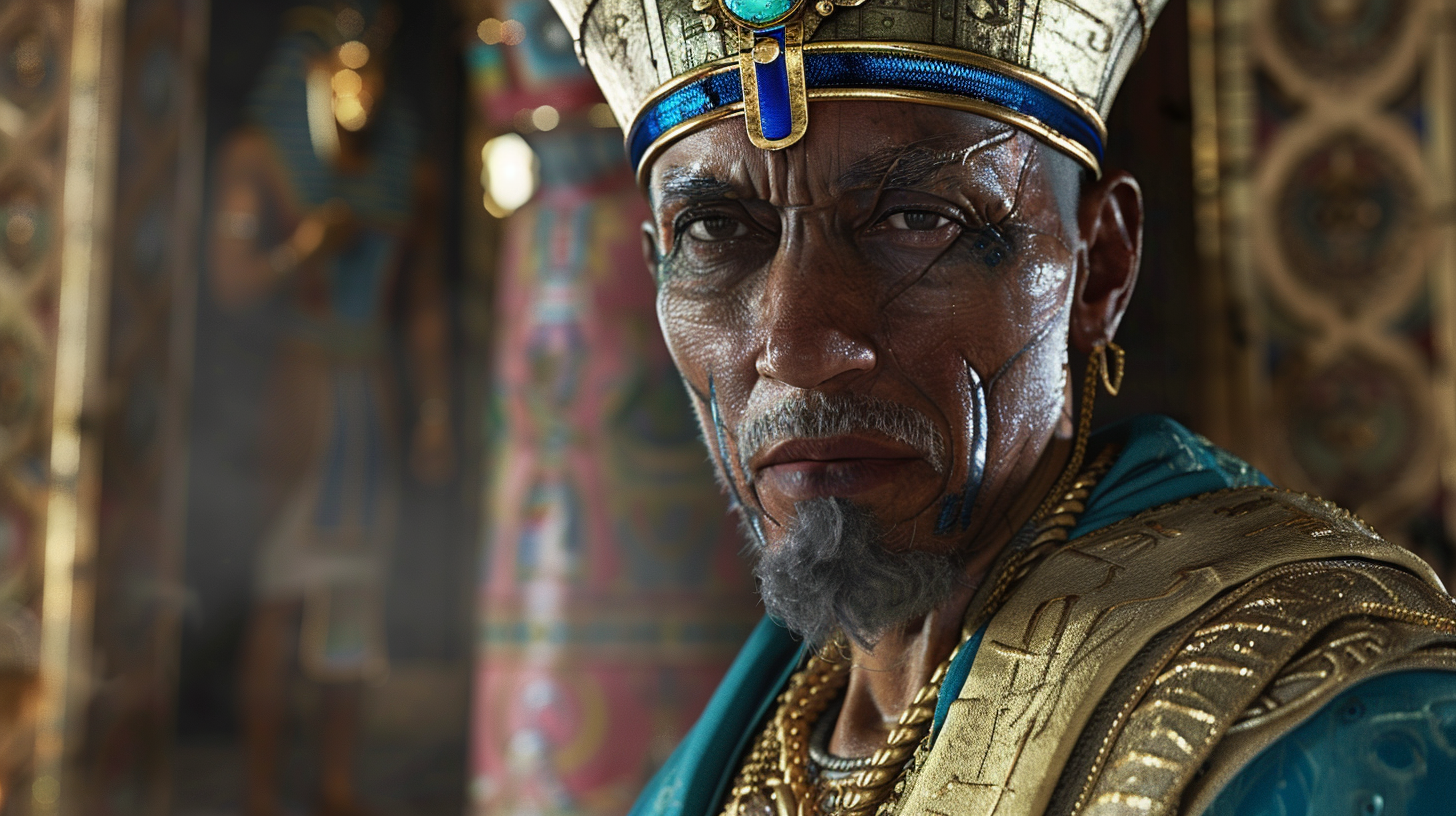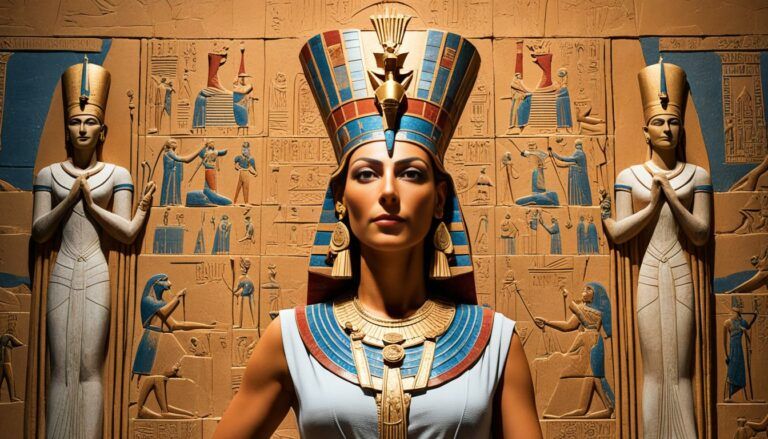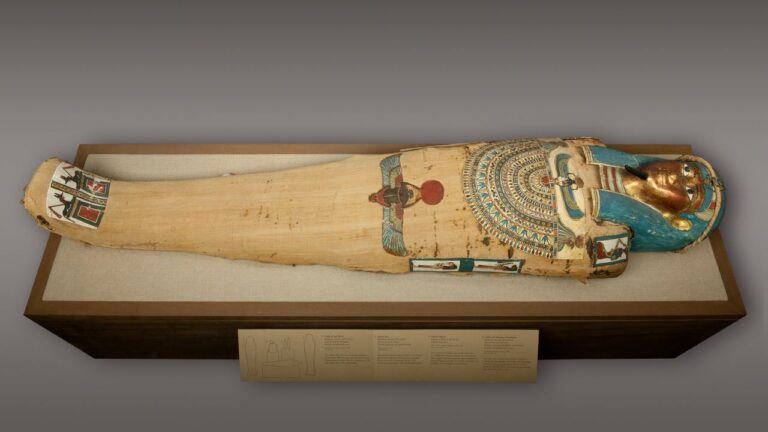What Did Priests Wear in Ancient Egypt?
In Ancient Egypt, the attire of priests was designed not only to reflect their sacred status but also to conform to the religious and cultural norms of the time. Priests played a central role in the spiritual life of the community, and their clothing was an integral part of their function within the temples. The garments they wore while performing rituals were distinctive, often setting them apart from the laypeople and associating them more closely with the gods they served. Cleanliness was considered essential to their sanctity, and therefore, materials such as linen, known for its purity, were the fabrics of choice. Let’s explore what did priests wear in Ancient Egypt?

The daily life of a priest in Ancient Egypt involved a series of ritualistic duties, and their clothing was a physical manifestation of their devotion. Priestly garments were typically white, symbolizing purity, and included items such as a simple knee-length kilt and a sash or headdress, which could be adorned with specific symbols relevant to their deity. The fashion choices of ancient Egyptian priests were not only about aesthetics but also about their deeply held beliefs, with certain clothing items believed to carry protective properties or signify a connection to the divine.
While male and female priests could perform similar functions and wore comparable clothing, specific details in their dress could vary depending on the deity they served. Their attire was not purely functional—decorative elements were sometimes incorporated, especially for high-ranking priests, who might have access to more elaborate and adorned garments. Overall, the clothing of ancient Egyptian priests was a careful balance between practicality, religious symbolism, and the prevailing fashion of the time, underlining the great cultural importance of clothing and appearance in the ancient world.
Priestly Garments in the Religious Sphere

Priestly attire in ancient Egypt was a critical aspect of the religious ceremonies conducted within temples. These garments were not merely clothing but a complex tapestry of symbolism, materials, and designs that signified the priests’ roles as intermediaries between the gods and the people.
Symbolism and Colors
Priestly garments were often white, a color that symbolized purity and sacredness in ancient Egyptian culture. The fabric used was predominantly linen, chosen for its association with lightness and its origin as a product of the earth, which linked the priests to the gods they served. The colors and materials of the garments carried significant meaning and were an essential part of the ritualistic functions of priests.
Ritual Accessories
Priests accessorized their attire with various items that held symbolic significance. Jewelry like the ankh, a symbol of life, was commonly used for protection and as an amulet. They also wore elaborate sashes around their waists, which signified their status and roles. These accessories were not mere decorations; they were imbued with religious meaning and considered necessary for the proper fulfillment of the priests’ duties.
Headwear and Footwear
Headwear was another crucial component of the priestly costume. The nemes headdress, often seen on pharaohs, was also worn by priests on specific occasions. As for footwear, priests were usually barefoot as a sign of humility before the divine entities, but in some situations, they donned sandals made of leather or papyrus. Whether barefoot or sandaled, the priests’ choice of foot attire was always deliberate and symbolic, demonstrating reverence and maintaining ritual purity within the holy confines of the temple.
Materials and Fabrication
In the construction of attire for priests in ancient Egypt, linen was predominantly used due to its cool and lightweight properties, ideal for the hot climate. The production of linen and the application of dyes were meticulous processes that reflected the society’s precision and value for religious garment craftsmanship.
Textile Production
Ancient Egyptians turned to flax plants to produce linen fibers, the cornerstone of their textile industry. Cultivating these plants along the Nile, they harvested them at just the right time to ensure fibers of the highest quality. The process of weaving linen was intricate; they separated the plant’s fibers, spun them into thread, and then wove them into fabric using horizontal looms.
- Steps in Linen Fabrication:
- Harvest flax plants.
- Retting process to separate fibers.
- Spinning fibers into threads.
- Weaving threads into fabric.
Though wool was available, it was considered impure by priests and rarely used in their garments. Linen, on the other hand, symbolized purity and was exclusive to religious and royal attire.
Dyes and Colors
The natural color of linen ranged from creamy white to light brown; however, the use of dyes allowed for vibrant colors to signify status and function. Importing vivid blue and green pigments from abroad, they achieved richly hued clothing that stood out in religious ceremonies. The color red, though less common due to its association with chaos, was sometimes used in attire for specific rituals.
- Common Dyes:
- Blue: Derived from plants and minerals like azurite.
- Green: Made using a combination of blue and yellow dyes.
- Red: Obtained from ocher and other minerals, but used sparingly.
Pleats and folds were engineered into the fabric, serving not just an aesthetic purpose but also demonstrating the wearer’s rank and the fabric’s quality. The more intricate the pleating, the higher the craftsmanship involved and, consequently, the status of the wearer.
Variations by Rank and Period
In ancient Egypt, the attire of priests varied significantly based on their rank within the religious hierarchy and evolved through different periods such as the Old, Middle, and New Kingdoms.
Distinctive Attire of High Priests
High priests, being at the apex of the temple hierarchy, often wore more elaborate and intricate garments than their lower-ranking counterparts. During important ceremonies, high-ranking priests, including those serving the pharaohs, donned garments that set them apart from other clergymen. For instance, a high priest might wear a leopard skin over a linen robe, symbolizing a connection to the power and divinity of the god they served. They were also known to wear shawls and headdresses with specific emblems denoting their status.
Changes Across Dynasties
From the Early Dynastic Period through to the New Kingdom, priests’ clothing underwent changes, reflecting shifts in fashion, resources, and religious practices. In the Early Dynastic Period, priests, like commoners, were depicted wearing simple kilts. As time progressed into the Old Kingdom, there was a clear distinction in the garb worn by upper-class men, who favored more refined and complex linens. By the Middle Kingdom, priests had incorporated embellished robes and specific colors into their vestments, indicating their position and function within the complex temple society. The evolution of priestly garments continued in the New Kingdom, showcasing a greater variety of fabrics and even more distinctions in attire related to the priests’ roles and ranks.
Influence and Legacy
The attire worn by priests in ancient Egypt had a profound impact on the social fashion of the civilization and ingrained itself into art and culture, symbolizing both religious and societal stature.
Impact on Social Fashion
Within ancient Egyptian society, the clergy’s clothing influenced the upper echelons’ styles, often featuring linen garments, gold accessories, and intricate patterns that reflected their importance. Nobles and royalty frequently adopted similar fashion elements to denote their own status, incorporating jewels, beads, and even semi-precious stones like lapis lazuli into their garments. The priests’ practice of shaving heads was adopted not only as a symbol of cleanliness and purity, but it became a reflection of style and dignity among the Egyptians.
Representation in Art and Culture
In tombs and temples, the presence of priests is a constant theme. They are depicted in paintings and artifacts wearing intricate cloaks, adorned with a complex array of vibrant colors and symbols. This rich representation cemented their image and attire as an iconic element of ancient Egyptian civilization.
Moreover, the use of kohl as eyeliner was not just a beauty product but also served to protect the eyes from the sun — a practice well-documented in art, where both the kings and queens exemplified this cosmetic’s use. The meticulous depictions in tomb paintings and statues, frequently decorated with faience and glass, etch the legacy of Egyptian priestly fashion as a testament to a civilization that placed immense value on appearance, both in life and in the afterlife.







